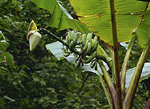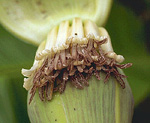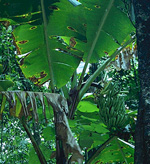 |
This is a small and distinctive family of the old-world tropics and sub-tropics, typified by the commercial banana.
Characteristic features of the family Musaceae in Australia include: - perennial rhizomatous herbs, often tree like, with pseudostems formed by sheathing petioles
- leaves alternate, entire, very large, with a thick mid-rib and pinnate venation
- inflorescence a terminal raceme of numerous irregular flowers enclosed in inflorescence bracts, on a thick stalk, erect or hanging
- perianth in two series of 3 segments, with 5 united and one free and unequal in size;
- stamens 6, usually including a posterior sterile one; ovary inferior and of 3 fused carpels
- fruit an elongated fleshy berry
Description
Perennial terrestrial herbs or apparently small trees (actually giant herbs). Perennating by corms or rhizomes. Vegetative reproduction by corms, rhizomes or stolons. Internal secretions not obvious or of coloured sap. Plants glabrous. Leaves alternate and spiral, cauline, petiolate. Stipule-like lobes absent. Lamina simple, symmetric, filiform, acicular, subulate, linear, lanceolate, ovate or oblong; base cuneate, cordate or attenuate; margins entire, ±flat; venation pinnate, with the midrib conspicuous, and the tertiary venation not reticulate; surfaces not punctate; leathery. Leaf ligule absent. Male and female flowers occurring on the same plant, or occurring together with bisexual flowers. Inflorescences terminal, consisting of racemes, panicles or monochasial cymes. Spathes present. Bracts present. Pollination by insects, birds or bats. Flowers stalked. Floral disc absent; nectaries present on the carpels. Perianth irregular, of 2 whorls or apparently 1 whorl only, or vestigial, with (3–) 6, petaloid segments, which may be free or fused, or some fused and others free, 1 or 2 lipped, with palate, tubular or curved-tubular, cream, yellow or purple, without contrasting markings, or streaked, spotted, etc; inner perianth parts herbaceous, succulent, petaline or membranous. Fertile stamens 5, not clearly correlated with and free of the perianth segments, free of the ovary and style, distinct from each other, all ±equal. Staminodes present or absent. Anthers basifixed, not versatile, opening inwards by longitudinal slits, 2-celled. Ovary inferior. Carpels 3, fused; ovary with 3 locules. Style terminal, single and unbranched, or single and branched above. Ovules numerous, sessile; placentation axile. Fruit a fleshy indehiscent berry; the perianth on the maturing fruit deciduous. Disseminule micro-surface ±smooth, yellow, orange or red, dull. Seeds numerous per fruit. Aril absent. Cotyledons 1. Embryo straight.
(Note: this description has been generated from the coded data compiled for the key. Any errors in the key data will be reflected in the descriptions.)
A treatment of the family Musaceae has been published in:
Flora of Australia 45: 16-19.
Australian genera of Musaceae (as recognised for the Flora of Australia)
Musa

|
  |

Musa acuminata (fruits)
Photo: J.Wrigley © ANBG

Musa acuminata (male flowers)
Photo: J.Wrigley © ANBG

Musa banksii (habit)
Photo: H.Nicholson © H. & N. Nicholson
|
 |
|